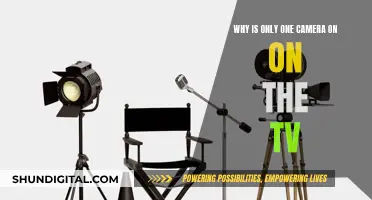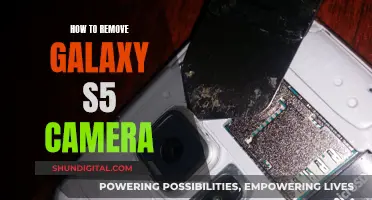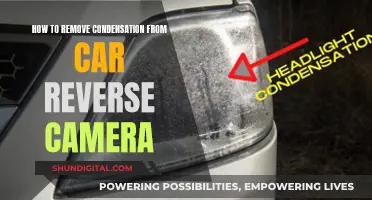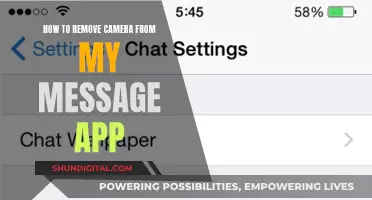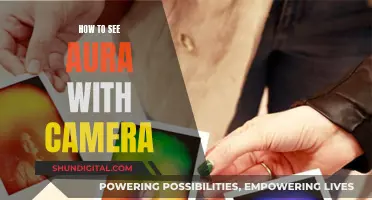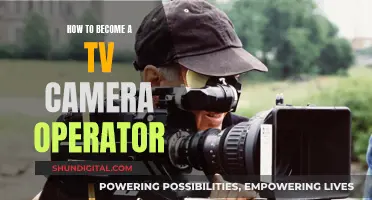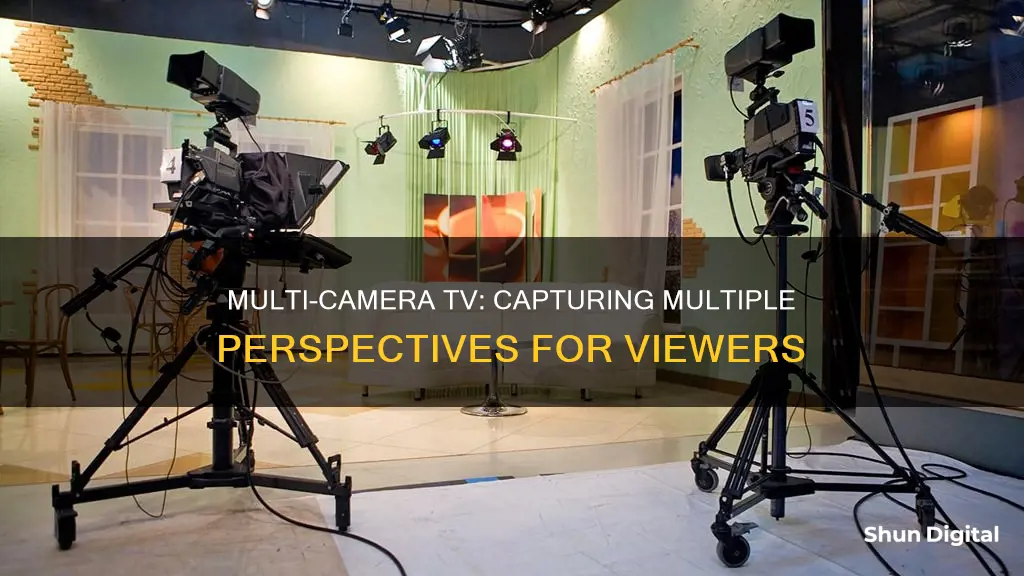
Multi-camera TV shows are those that are filmed in front of a live audience, or on the same set, using three or four cameras simultaneously. Multi-camera TV shows are often sitcoms, and the multiple cameras allow for multiple takes at once, giving more options in the edit. Multi-camera TV shows are usually much cheaper to produce than single-camera shows, and they can be shot in just a few hours.
| Characteristics | Values |
|---|---|
| Number of cameras | Multiple cameras are used simultaneously to record or broadcast a scene |
| Camera angle | The two outer cameras shoot close-up shots, while the central camera(s) shoot a wider master shot |
| Lighting | Setup is less optimised and needs to provide a compromise for all camera angles |
| Equipment placement | More complicated to set up and inferior placement of equipment such as microphone booms and lighting rigs |
| Recording capacity | Requires more digital storage space per take compared to a single-camera setup |
| Synchronisation | All cameras must be synchronous to assist with editing and avoid different scan rates |
| Editing | Less time spent in editing as there is no need to restart action for different angles |
| Production cost | More expensive than single-camera setups due to requiring multiple cameras and setups |
| Production time | Faster to shoot as there is no need to re-light or change setups for different angles |
| Live audience | Often performed in front of a live audience, but not always |
| Laugh track | Usually includes a laugh track, either from a live audience or added in post-production |
What You'll Learn
- Multi-camera TV shows are usually shot in front of a live audience
- Multiple cameras capture the story, with fewer takes
- Multi-camera is faster and less expensive than a single-camera setup
- Multi-camera sitcoms are formatted differently to single-camera scripts
- Multi-camera shows are often cheaper to produce

Multi-camera TV shows are usually shot in front of a live audience
Multi-camera TV shows are typically shot in front of a live audience, with multiple cameras capturing the story and fewer retakes. This setup is often compared to live theatre, with the cameras taking the place of the audience. The multiple-camera setup is particularly common for sitcoms, light entertainment, sports events, news, talk shows, game shows, variety shows, and soap operas.
Multi-camera productions are usually faster and more cost-effective than single-camera setups. They can be shot in just a few hours, with multiple takes captured simultaneously, providing a range of options for editing. This efficiency is especially beneficial for shows that need to be aired shortly after filming, such as daily soap operas. The setup also simplifies continuity tracking and reduces the need for relighting and resetting camera angles.
The multiple-camera approach allows for a more dynamic viewing experience, with different shots and angles captured as the action unfolds. This method suits shows that require a live audience and want to capture the energy and laughter of the crowd. The actors can feed off the audience's reactions, and a laugh track can be recorded to encourage at-home viewers to enjoy the humour.
However, one of the drawbacks of the multi-camera setup is the challenge of optimising lighting for all camera angles. It can also be more complicated to position equipment, such as microphone booms and lighting rigs, without them being visible in the shot. Additionally, the usage of recording capacity increases with each additional camera, requiring more film or digital storage space.
Roku TV: Camera-Equipped or Not?
You may want to see also

Multiple cameras capture the story, with fewer takes
The multi-camera setup, also known as multicam, is a method of filmmaking, television production and video production. Multiple cameras are used on set to simultaneously record or broadcast a scene. The two outer cameras typically capture close-up shots of the two most active characters, while the central camera(s) capture a wider master shot to establish the geography of the room. This setup allows for multiple shots to be obtained in a single take, reducing the need for re-lighting and alternative camera angle setups.
Multi-cam is often used for live television, including light entertainment, sports events, news, soap operas, talk shows, game shows, variety shows, and sitcoms with a live studio audience. It is particularly suitable for shows that require a live audience as the action unfolds chronologically.
Multi-cam productions can be filmed or taped much faster than single-camera productions. Single-camera productions are shot in takes and various setups, with components of the action repeated several times and out of sequence, making them unsuitable for viewing by a live audience.
Multi-cam is also more engaging for viewers, with multiple angles, wide-angle shots, bird's eye views, and tight shots of the broadcaster speaking to the audience. This setup helps visually explain the narrative better to the audience with fewer words.
However, multi-cam setups also come with challenges. They require more equipment, staff, skills, and data management. The lighting setup is also less optimised as it needs to provide a compromise for all camera angles.
Can My TV Spy on Me?
You may want to see also

Multi-camera is faster and less expensive than a single-camera setup
In television, film, and video production, the single-camera setup is a method in which all shots and camera angles are taken using the same camera. In contrast, the multiple-camera setup involves using several cameras to capture different angles of a scene simultaneously.
The multiple-camera setup is faster and less expensive than a single-camera setup. Here's why:
Faster Production
With multiple cameras, different shots can be obtained in a single take without stopping the action to reset the camera. This is especially useful for shows that need to be aired shortly after filming, as it reduces the time spent in the editing room. Additionally, there is no need to relight the set or adjust camera angles for each shot, further speeding up the filming process.
Reduced Editing Time
The multi-camera setup saves time in post-production as well. Since all the necessary shots are captured simultaneously, there is no need to spend time editing together different camera angles. This is particularly beneficial for shows with frequent back-and-forth cuts between characters, as the outer cameras can focus on close-ups of the active speakers.
Cost Savings
The multi-camera setup also reduces costs by streamlining the production process. With fewer camera setups and less time spent on filming and editing, productions can save money on equipment, crew, and talent. Additionally, the simplified lighting requirements in a multi-camera setup can lead to cost savings, as the lighting setup is optimized for all camera angles at once, rather than needing to be adjusted for each individual shot.
While the multi-camera setup offers advantages in terms of speed and cost, it's important to note that it provides less flexibility and control for the director compared to a single-camera setup. The single-camera setup allows for more intricate lighting, camera movements, and visual effects, making it the preferred choice for certain types of programming, such as prime-time dramas and feature films.
Spying on Someone: Hacking Their Camera for Surveillance
You may want to see also

Multi-camera sitcoms are formatted differently to single-camera scripts
Multi-camera sitcoms are formatted differently from single-camera scripts. The two formats differ in terms of their shooting style, script presentation, and the overall viewing experience.
Multi-camera sitcoms are typically filmed in front of a live studio audience, with three or four cameras capturing the performance simultaneously. This style creates a sense of theatre, as the actors feed off the energy of the crowd. The multiple cameras allow for different shots and angles to be captured in a single take, reducing the need for re-lighting and alternative camera setups. This results in a faster and more efficient production process, making it ideal for shows that air shortly after filming, such as daily soap operas.
In contrast, single-camera comedies are usually shot without a live audience and are more similar to feature films in their production style. They often involve location scouting and dedicated crews, allowing for more experimentation with shots and angles. While single-camera shows may use multiple cameras to capture a scene, they are edited to maintain a single perspective, resulting in a more cinematic viewing experience.
The scripts for multi-camera and single-camera shows also differ significantly. Multi-camera scripts have distinct formatting characteristics, such as action lines and scene descriptions in ALL CAPS, underlined scene headings, and double-spaced dialogue. They tend to be longer, typically ranging from 52 to 58 pages for a 22-minute episode. On the other hand, single-camera scripts follow a more traditional format, with regular capitalization and single-spacing for action lines and dialogue. These scripts are generally shorter, ranging from 25 to 35 pages for a 22-minute episode.
The choice between multi-camera and single-camera production has a significant impact on the final product. Multi-camera sitcoms often include a laugh track, creating a communal viewing experience reminiscent of radio shows and early television. In contrast, single-camera comedies offer a more immersive and cinematic experience, allowing for tighter editing and the use of multiple locations and visual effects.
Hotel Cameras: Privacy or Security?
You may want to see also

Multi-camera shows are often cheaper to produce
Multi-camera TV shows are often cheaper to produce than single-camera shows. This is because multi-camera shows are faster to shoot and edit, requiring less time to be spent on filming and post-production.
Multi-camera sitcoms are usually filmed in front of a live studio audience, with multiple cameras capturing the necessary angles in just one take. This means that there is no need to stop and start the action, and the actors can feed off the energy of the crowd. In contrast, single-camera shows are shot in takes and various setups, with the action repeated several times and out of sequence, making them unsuitable for viewing by a live audience.
Multi-camera shows also save time in editing, as there is no need to set up alternative camera angles or deal with complex continuity issues. The multiple shots obtained in a single take can be arranged sequentially in editing to create a seamless experience for the viewer. However, one drawback of multi-camera setups is that they require more recording capacity, as a four-camera setup may use up to four times as much film or digital storage space per take compared to a single-camera setup.
In addition, multi-camera shows are often simpler in terms of lighting and equipment setup. Single-camera shows may require dedicated crews, location scouts, and set builds, whereas multi-camera shows are usually filmed on a stage set before an audience. While multi-camera shows may have inferior lighting setups due to the need to compromise for all camera angles, single-camera shows have the advantage of being able to hide equipment such as microphone booms and lighting rigs more easily.
Overall, the faster production and editing process of multi-camera shows makes them a more cost-effective option for television production, especially for high-output shows like daily soap operas.
Pinhole Camera Eclipse Viewing: A Safe, Easy Guide
You may want to see also
Frequently asked questions
Multi-camera TV, also known as multi-cam, is a filming technique where multiple cameras are used to capture a scene simultaneously.
Three or four cameras are typically used in multi-camera TV, spread across the set.
Multi-camera TV has several advantages, including the ability to capture multiple takes at once, providing more choices in the editing process. It is also usually cheaper and faster to produce than single-camera TV, as episodes can be shot in just a few hours.
Popular multi-camera TV shows include "Seinfeld", "Friends", "Two and a Half Men", and "Fresh Prince of Bel-Air".
Multi-camera TV scripts have a distinct format. They include underlined slugs/scene headings, action and description in ALL CAPS, underlined character names for new characters, and double-spaced dialogue.


